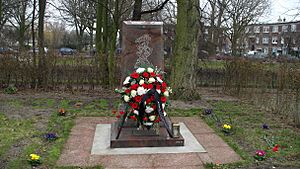Khojaly Massacre facts for kids
Quick facts for kids Khojaly massacre |
|
|---|---|
| Part of the First Nagorno-Karabakh War | |

Khojaly massacre memorial in The Hague, Netherlands
|
|
| Location | Khojaly, Nagorno-Karabakh |
| Target | Azerbaijani civilians |
| Deaths | 200+ (per Human Rights Watch) 485 (per Azerbaijani parliament) 613 (per Azerbaijani government) |
| Assailants | Armenian forces 366th CIS regiment |
The Khojaly massacre was a terrible event where many Azerbaijani civilians were killed. This happened in the town of Khojaly on February 26, 1992. It was carried out by Armenian forces and soldiers from the 366th CIS regiment. This event was the largest single killing of people during the whole Nagorno-Karabakh conflict.
Khojaly was a town where about 6,300 Azerbaijani people lived. It was located in the Nagorno-Karabakh Autonomous Oblast of Azerbaijan SSR. In 1992, the town also had the region's only airport. During the First Nagorno-Karabakh War, Armenian forces often attacked Khojaly with bombs. They also completely blocked the town, stopping supplies like electricity, gas, and water.
The town was defended by about 160 local men who were not heavily armed. Armenian forces, along with some troops from the 366th CIS regiment, started a big attack in early 1992. This forced almost all the Azerbaijani people in the area to try and escape. As they fled, terrible acts of violence happened to them.
The Khojaly massacre was a major turning point in the First Nagorno-Karabakh War. Azerbaijani officials say 613 civilians died. This number includes 106 women and 63 children. Human Rights Watch reported that at least 200 Azerbaijanis were killed. Some estimates suggest that between 500 and 1,000 people might have died. This includes both fighters and people who died from the cold.
What it's Called
Most governments and news groups call this event a massacre. This means a large number of people were killed in a cruel way. In Azerbaijan, people often call it a tragedy (Azerbaijani: Xocalı faciəsi). They also sometimes call it a genocide (Xocalı soyqırımı). A genocide is when a large group of people are killed, often because of their ethnic background.
Why it Happened
The Nagorno-Karabakh conflict was a war between Armenians and Azerbaijanis. Both sides suffered from violent attacks and forced displacement. This means many people were killed or had to leave their homes. By 1992, the conflict had become a full-scale war. In February 1992, the main city of Nagorno-Karabakh, Stepanakert, was surrounded by Azerbaijani forces.
In 1988, Khojaly had about 2,135 people living there. Because of the war, many people moved between Armenia and Azerbaijan. Also, Meskhetian Turk refugees from Central Asia settled in Khojaly. This made the town's population grow to 6,200 by 1991.
Khojaly was important because it was on the road connecting Shusha and Stepanakert to Aghdam. It also had the only airport in the region. This airport was very important for people in Karabakh. They had no other way to get supplies because Azerbaijan had completely blocked the land routes to Armenia. Human Rights Watch stated that Azerbaijani forces used Khojaly to launch attacks on Stepanakert.
In October 1991, the Nagorno-Karabakh forces cut the road between Khojaly and Aghdam. After this, the only way to reach Khojaly was by helicopter. The Memorial civil rights group reported that Armenian armed forces had practically blocked Khojaly since autumn 1991. When Soviet troops left Karabakh, the blockade became complete.
Some people left the blocked town. However, many civilians stayed, even though the head of Khojaly, Elman Mammadov, urged them to leave. Khojaly was defended by local police forces called OMON. These forces were led by Alif Hajiyev and had about 160 lightly armed men. Armenian forces bombed Khojaly almost every day in the winter of 1991–1992. People got used to spending nights in basements. They also had to live without electricity, gas, or water because of the blockade.
Warnings and Escape Routes
The Memorial report mentioned that the Armenian side said they offered a safe path for civilians to escape. They claimed they told the people of Khojaly about this "corridor" using loudspeakers on armored vehicles. Officials also said they dropped leaflets from helicopters days before the attack. These leaflets supposedly told people to use the "free corridor."
However, Memorial's observers were not given any copies of these leaflets. They also did not find any traces of such leaflets in Khojaly. When Khojaly refugees were asked, they said they had not heard about any leaflets. Witnesses interviewed by Helsinki Watch on the Azerbaijani side also said they did not know about a corridor beforehand.
Remembering the Event
Many memorials have been built to remember the Khojaly massacre. These memorials are in Azerbaijan and other countries around the world. They help people remember the victims and the tragic events that happened.
See also
 In Spanish: Masacre de Jóyali para niños
In Spanish: Masacre de Jóyali para niños
- Maraga massacre

